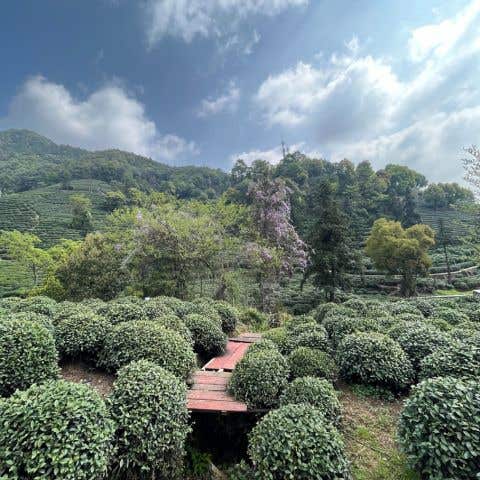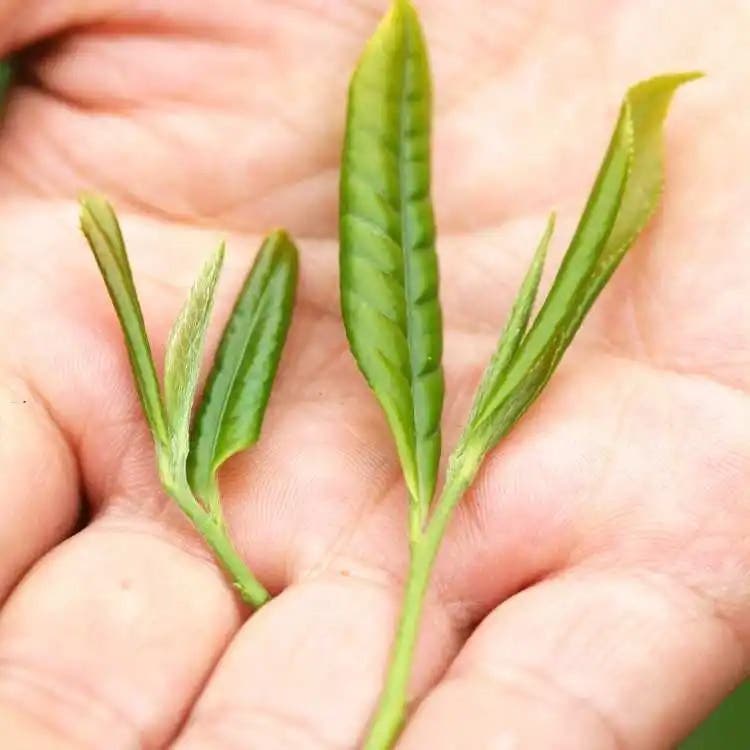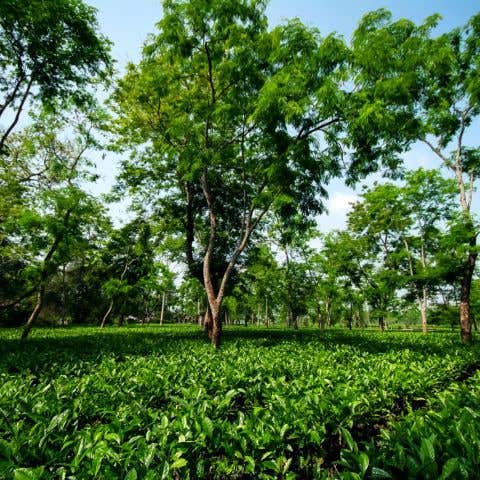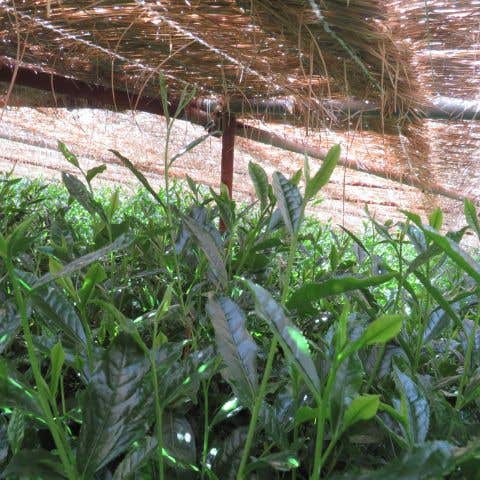
A view of a tea garden in spring bloom, Hangzhou, China.
The arrival of spring is a sight not to be missed while venturing outdoors in the UK over the past few weeks, as is the same over the northern hemisphere – including at source in many of our tea gardens. As nature awakens from its winter hibernation, the air has come alive with a gentle warmth and a renewed sense of optimism. Delicate blossoms grace the trees, painting the landscape in vibrant hues, and delicate buds have burst forth from the branches, revealing fresh growth, that infuse the air with a vibrant energy.
It might not be immediately obvious as we see tea throughout the year on our supermarket shelves, but tea is a very seasonal product; some teas are only produced for a few weeks during a specific season each year. The best places for tea production have distinctive seasons and so the tea bushes change throughout the year, meaning the season in which the tea is produced defines how a tea will taste.
For me, one of the biggest rewards from drinking single garden teas over blended tea is the variety of unique and distinctive flavours that they give and the wonderful places these different taste journeys take you to. Take for example, a cup of Dragon Well green tea from Hangzhou – it’s grassy, fresh character transports you to a moment of pure spring refreshment that is completely different to the comfort and warmth delivered by a rich malty Assam black tea, which in turn is completely different to the vigour and discovery offered by the cocoa, rose and fruity complexity of an oolong from the craggy mountains of Wuyishan.
Approaching these places and their teas seasonally will help to you know which teas to seek out and when to drink them. Connect your choice to the seasons or to your mood – some teas will refresh and cool with grassy flavours, and some will warm and comfort with nutty, caramel or ripe fruit flavours.
A useful rule of thumb to start with is to match production and drinking seasons, so drink teas produced in spring in the springtime, drink autumn oolongs in autumn etc. Read on to work out what your tea calendar might look like.
The Four Seasons of Tea

Tea gardens in the Spring in Jiande, Hangzhou.
Spring
This is often the most renowned picking season for tea, especially in the oldest tea origins. Spring is when the fresh new buds and young leaves appear on the tea bushes after a dormant period during the cool winter when just the roots have been working underground. In these places spring buds are the most highly prized because they contain all the flavour and nutrients stored up over winter, making them succulent, richly textured, and particularly aromatic. Such places are all in the Northern Hemisphere and so spring pickings begin around early March and last just a few weeks.
The very best spring teas will encapsulate spring freshness – they’re typically floral, green and very refreshing; often light and delicate but with thick, velvety bodies.

New buds with two young leaves are often the most highly prized picking of any season.

The Dragon Well leaves are flat and spear shaped from being pressed against the side of a hot wok or surface during processing.
Teas to expect in Early Spring
Dragon Well or Long Jing from Hangzhou in Eastern China. It’s China’s most famous green tea, and one of its most prized. The seasons change fast in this area, and so the production period is only around four weeks. It begins in March, when the days are warm enough for the tea bushes to grow buds, but not so hot that they grow too quickly and don’t have enough time to develop flavour. Dragon Well tea should be smooth and creamy with a characteristic sweet hazelnut flavour imparted from the frying of the leaves during the processing. A cup of Dragon Well will have a refreshingly grassy quality that perfectly reflects the spring season.
Darjeeling 1st Flush. Darjeeling is in the foothills of the Himalayas, so the tea bushes have very cool and long winters. When spring comes the first shoots and leaves are picked for production of what’s known as “first flush tea”. Not only will this tea contain all of the nutrients and energy that the bushes have had the time to develop over the winter, but the altitude means that the spring days are still cool and so even when the leaves are bruised, their flavours concentrate very slowly. This enables the producers to create the completely unique partially oxidised first flush. This tea offers something quite unique among Indian teas and is known for its crisp and quenching flavour with prominent notes of grape and hay. An embodiment of the green and luscious hills of Darjeeling in the crisp springtime.

Baojing Gold infusing in a one cup tea-iere.
Baojing Gold is an example of a local spring green tea from China. Qing Ming is a spring festival in China and traditionally it is a time to pay respects to one’s ancestors. Nnowadays it’s also very often marked by families visiting tea gardens and selecting their green tea for the year. The teas that are chosen will be the teas that families will drink and enjoy together throughout the year but also use as gifts, so everyone is looking for the highest quality they can find. Spring teas are highly prized at origin and so most rarely find their way outside of China. Instead they’re very often snapped up by local families as the fresh batches are produced. Baojing Gold is from Ludong Mountain in Baojing County, China. It was expertly crafted by tea master Mr Long, who does much of the processing, such as drying the delicate young buds, by hand. This tea has a refreshing but rich character, capturing the purest essence of the tenderest buds and leaves with a pleasant umami balance and a meadow-sweetness.
Silver Needle White Tea from Fuding in Southern China. A white tea with much prestige from Fujian province. Silver Needle is made only from the young buds of the tea plants as they begin to flourish in early spring. This is therefore considered the highest grade of white tea and is simply processed by slowly withering and drying the buds over a few days. Silver Needle retains much of the purest flavours of the tea plant due to its minimal processing. The infusion is smooth and syrupy, with the best examples having notes of refreshing cucumber and sweet melon.
Teas to expect in Late Spring
Sencha is Japan's most popular style of green tea. The leaves are usually picked in mid-May with farmers eagerly awaiting the clear, blue skies of late Spring to begin their busy harvest season. Once picked, hot steam is used to halt any natural oxidation, maintaining a rich, green colour in the leaves. This also gives the tea is flavourful umami taste, which Japanese green tea is known for. With Sencha you can expect plenty of sweetness and a refreshing green taste from the verdant leaves, balanced by a rich umami and a satisfying, thick texture.

Producer Ishiyama inspects the Spring pick from his Sencha tea garden.
Jade Sword ™ from Hunan, China. This tea comes from a less celebrated region than some of the other more famous green teas, but it still captures the bright and alluring freshness of Spring. It’s methodical processing by local producer Zhou Wei gives the tea a smooth profile without any bitterness. Instead it’s full of sweetness from the tender buds and fine, young green leaves that offer a great introduction to this style of Spring tea.
Summer
In early June, the hot summer sun arrives in the tea gardens and encourages the bushes to grow fast, changing their flavour. The flavours change because the plant starts to produce compounds which will protect the leaves from insects, or the sun’s heat and its UV rays. Summer picking is preferred for making teas with stronger, more robust flavours.

The large leaves of these assamica tea bushes in Assam are full of rich and robust character.
Teas to expect in Summer:
Assam Breakfast. In Assam we focus on the ‘second flush’ season which is a period of roughly two weeks in which the most distinctive tasting and sought-after tea is produced. It is usually the first couple of weeks of June and is the sweet spot between the spring flush when the leaves have limited strength in them, and the monsoon rains when the leaves will get watered down and the tastes tend towards bitterness. The best second flush tea buds and leaves captured during this short season will have a golden tipped appearance after they have been processed which is indicative of the rich, malty and dried fruit flavours that Assam is known for.
Darjeeling 2nd Flush. After the first flush spring harvest in Darjeeling comes the summer picking during the hotter months of May and June. This is known as the second flush, with the leaves picked during this time being used to make a much more traditional black tea. This season benefits from hotter days and cooler nights which helps the tea bushes to flourish and develop their flavours. Once picked the leaves are rolled to induce oxidation and produce a traditional black tea with depth and richness, while maintaining the crisp and refreshing character of Darjeeling.
Oriental Beauty from Mr Chen’s garden in Taiwan. This is an oolong tea that’s also known locally as ‘bug-bitten tea’ because of the pests and insects that feed on the tea plants during the Summer. The hotter weather along with the bug bites induce a change in flavour in the leaves, as more terpenes are produced by the plants to protect themselves. Once processed, the tea displays an array of colours in the leaves, from coppery orange to dark purple with flashes of silvery buds. They produce a remarkably fruity, floral and complex flavour with lots of muscatel and floral notes too that reflects the abundance of summer gardens in one infusion.
Autumn
Tea plants often go through a late seasonal flush in the autumn around September to October time. This season will tend to produce thicker, strong leaves which are full of aromatic oils and can be much heartier than the fresh spring flourishes. Autumn is an important season for both oolong and puerh production.
Teas to expect in Autumn:
Cooked Puerh Mini Cakes from Yunnan in the south west of China. This compressed tea is a speciality of Yunnan and is produced most often in either Spring and Autumn. Yunnan province is an ancient terroir for tea growing and is home to some of the oldest tea forests in China of around 1000 years old. Traditionally, puerh is produced similarly to a green tea and then aged to develop its flavour over decades. But to speed that process up, the tea can be fermented in a ‘wet piling’ process for about a month to induce a very rich and uniquely earthy flavour. This also referred to as ‘ripe’ or ‘cooked’ puerh and is often found in a shape for storage, such as these mini ‘tuo’ cakes. These mini cakes produce a warm and nourishing infusion, with a supple and velvety texture that is full of incense woods, earthiness and a light fruit finish that is unlike any other tea you might have tried.

The tea gardens in Ali Shan covered in mist.
Ali Shan from Nantou, Taiwan. Oolong teas from the autumn/ winter harvest in Taiwan (also known as ‘Dong Pian’ or, winter leaf) are characterised by having a much richer fragrance than the spring picked teas due to the more developed leaves and cooler growing temperatures. The tea gardens at this time will be shrouded in hydrating mist. The tea plants used to make this oolong are the ‘Jin Xuan’ varietal which is known for its inherently milky flavour. So with Ali Shan oolong you can expect a plentiful aroma of fresh, baked cream with lots fruity hints. While the full, sappy flavour of the infusion offers a reviving and invigorating lift that carries through with those notes of baked cream, strawberry and pear.
Winter
In winter the temperatures can drop dramatically, which means the tea bushes in most place prepare for their dormancy. However, in more tropical origins, such as Sri Lanka and Taiwan, the maintained weather means that plants can continue to sprout even in the winter. The large temperature differences between day and night means the tea leaves get a good balance of nourishing sun and cooling night, helping them produce a balanced growth and flavour.
Teas to look for in Winter:
Ceylon Breakfast from Sri Lanka. This breakfast blend showcases the high quality tea leaves from the tropical regions of Ruhuna and Dimbula. Here, tea still flourishes through the milder winter months and the variety of altitudes between the two regions helps to express the very best of the island’s tea. Tea from the low growing gardens of Ruhuna are known for their rich, malty base and deep colour, while gardens in the heights of Dimbula produce tea with fragrant aromatics and refined structure. Together they create an outstanding breakfast infusion suitable for any time of year, with a lively and rich flavour, hints of sweet citrus and a luxuriously smooth texture.
Teas Which Cross the Seasonal Boundaries
Some teas go through extended processes to ensure a quality and authenticity when it comes to how they taste. This means the fresh tea leaves might be picked and partially processed during the spring to ensure the perfect start, then finished later in the year as the seasonal shifts allow time to create the final flavour.

You can taste the Wuyi mountains through the unique combination of minerality, fruitiness, cacao & structure in the cup.
Wuyi Oolong from Fujian province, China. Although this tea is picked and processed during the spring it might not be ready until the early autumn. This is because oolongs from the Wuyi mountains are typically roasted, either with charcoal or electric oven. This deepens the taste and creates a complex tea, accentuating the flavour of the mineral rich and rocky terroir, as well as producing notes that range from floral to cacao and dried fruits. Though it takes time for these flavours to develop and for the roast to calm which could be several months after the initial processing. But it’s worth the wait as the result of our current batch is a rich and autumnal infusion with warm, fragrant notes of rose and peach, a sublimely smooth texture and a characterful minerally finish.
Jasmine Silver Needle and Jasmine Pearls from Guanxi in Southern China. The base for these scented teas are both initially processed during the spring, with the fresh buds of the silver needle being crafted in Yunnan, and the bud and young leaves used for the green pearls are produced in Fujian. However, for a deep lasting fragrance, real Jasmine blossom is used which only flourishes in Guangxi province during early June. So after been stored for a few months the teas are transported to Guanxi and scented for five consecutive nights with fresh jasmine blossoms, which impart their true essential oils into the leaves. The result is sweet, floral, syrupy and unmistakeably authentic flavour that’s perfect in hotter weather as an indulgent and relaxing infusion.

You can taste the Wuyi mountains through the unique combination of minerality, fruitiness, cacao & structure in the cup.
Gyokuro from Shizuoka, Japan. In preparation for the spring harvest this green tea undergoes a traditional shading process for 30 days. As the weather begins to warm up the plants are covered with a canopy to block out the sunlight which causes the tea plants to struggle while sprouting their new leaves. In doing so they produce less bitter tannins and retain more of the amino acid L-Theanine, creating a thick, smooth and sweet infusion which transforms into an unforgettably rich umami finish. A great one to enjoy as fresh as possible in Spring for maximum refreshment and also perfect for a robust and flavourful cold infusion during the Summer.

